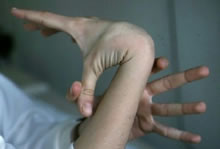Marfan Syndrome
Marfan syndrome is a genetic disorder that causes
connective tissues, which provide shape and support
to many parts of the body, not to be as stiff as they should.
Because these connective tissues are found throughout the body,
Marfan syndrome can affect many organs, including the skin, skeleton,
eyes, nervous system as well as blood vessels and heart.
Who Gets It?
It is estimated that about 1 in 10,000 to as many as 1 in 3,000
people in the United States have Marfan syndrome. Race and sex
makes no difference in prevalence of this condition - both men
and women of all ethnicities can have it.
Symptoms of Marfan Syndrome
The symptoms of Marfan Syndrome are:
- Tall, thin stature with long limbs
For most people, armspan and height are roughly equal - in people
with Marfan Syndrome, armspan is longer.
- Long, flexible fingers and toes

Extremely flexible, long fingers are a hallmark
symptom of Marfan Syndrome
- Easy dislocation and loose joints, as well as scoliosis
or abnormal side-to-side curvature of the spine
- Sunken or pushed-out breastbone
In some people with Marfan Syndrome, their ribs can outgrow
and push the breastbone in or out, resulting in either a hollow
spot or a bump. Although in most cases this is a minor and subtle
symptom, in severe cases it can cause compromise the heart's
and lung's functions.
- Vision problems
These include nearsightedness (myopia) and
off-center eye lense (ectopia lentis). People
with this condition are also prone to retinal detachment,
which is a medical emergency and often requires immediate surgery.
Left untreated, it can cause permanent blindness.
- Weak blood vessels (especially the aorta) and abnormal heart
valves
This is the most serious symptom of Marfan Syndrome: because
of weakened connective tissue, people with this condition can
develop aortic dissection (tear and weakening
in the inner layer of the aortic wall) and aneurysm
(a sudden and dangerous weakness in the wall that can cause
the blood vessel to baloon outward). Both of these conditions
can lead to fatal rupture of the aorta.
Weak connective tissues can also cause abnormalities in the
heart valves, especially in the mitral valves. Approximately
85% of all people with Marfan Syndrome develop mitral
valve prolapse, a condition where the valve leaflets
are too floppy and do not close properly.
In some people, the symptoms of Marfan Syndrome are very mild
and are usually not very noticeable.
Marfan Syndrome Causes
Marfan Syndrome is caused by a DNA mutation in the fibrillin-1
(FBN1) gene in chromosome 15. This causes mutation causes
various connective tissues to be weakened.
Treatment for Marfan Syndrome
There is no cure for this condition.
Early diagnosis of Marfan Syndrome in children is important to
prevent scoliosis and other skeletal deformities. If abnormal
curvature of the spine is present, a back brace may be necessary.
Children with this disorder also need regular health check ups
by an opthalmologist and a dentist. Sternous physical activities,
as well as contact sports, should be avoided.
Because of their weak aorta and abnormal heart valves, people
with Marfan Syndrome should take precautionary dose of antibiotics
prior to any medical or dental procedures to prevent bacterial
infection, such as endocarditis.
In Marfan Syndrome, abnormal heart valves and aortic wall can
make the heart beat faster and worker harder than it should. To
slow the heart and decrease its force of contraction, beta
blockers are often prescribed.
If the aorta becomes too enlarged, an aortic replacement surgery
may be necessary.
Prognosis
Left untreated, heart failure and aortic rupture from Marfan
Syndrome commonly causes death by the age of 40 and 50. With proper
medical treatment, however, the average lifespan is increased
to about 70 years.
Reference:
Marfan
Syndrome - eMedicine
Janis Cortese -
Marfan
Syndrome


